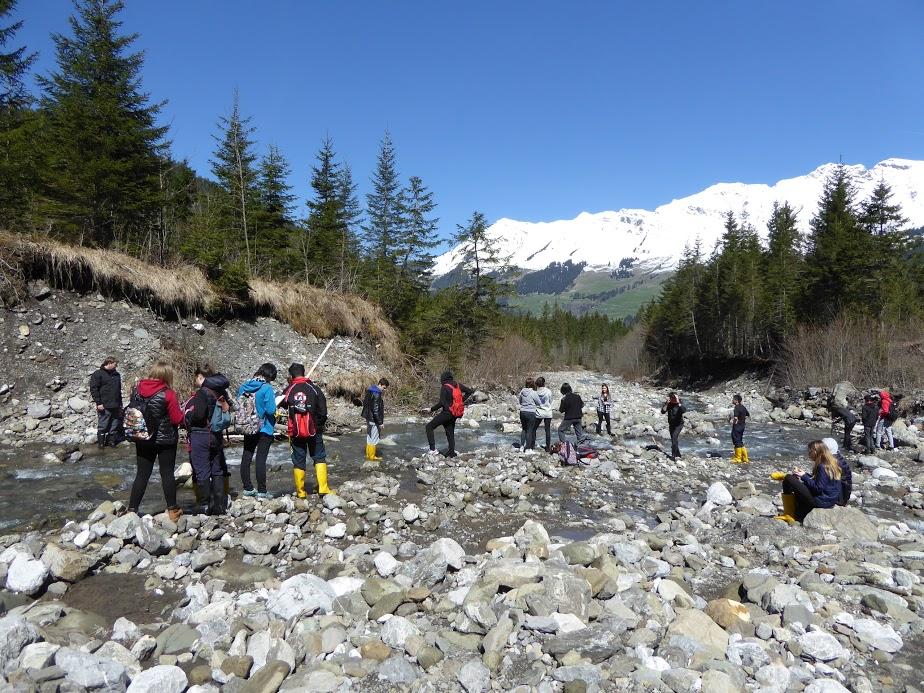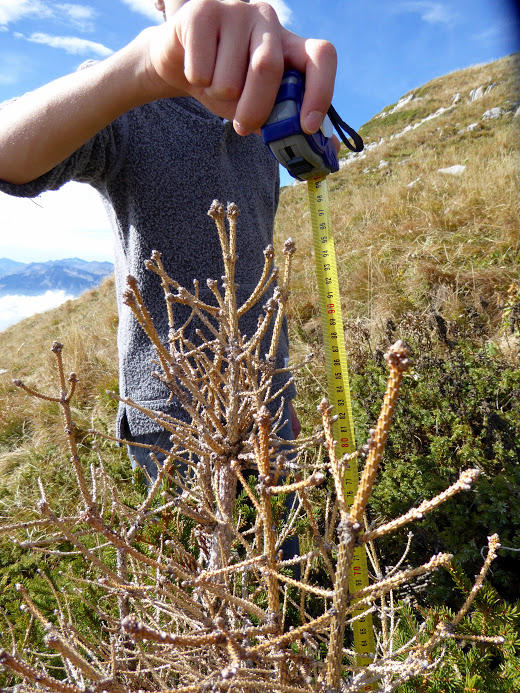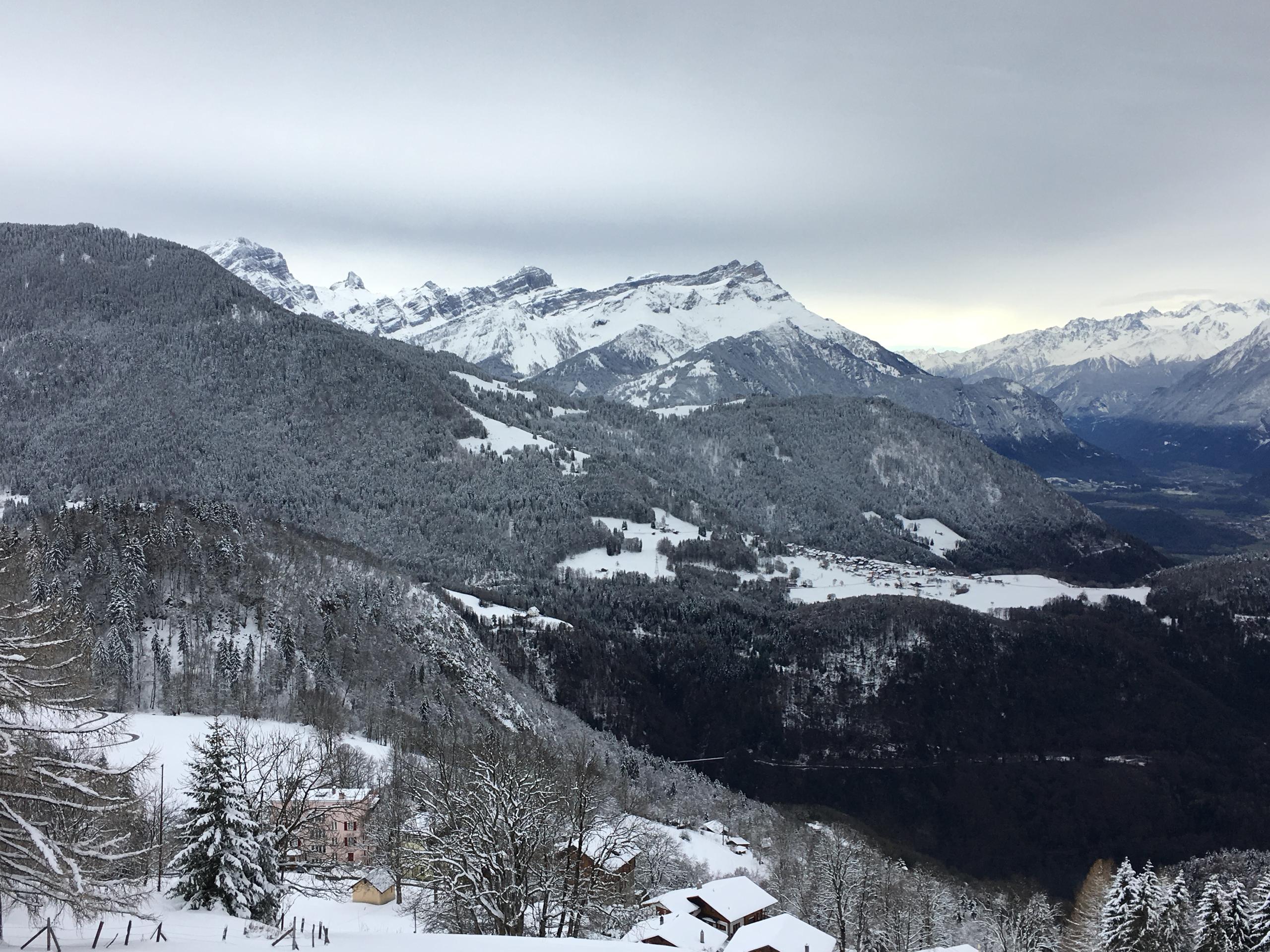
When science class produces real-world results

If data from school science projects doesn’t just go into the trash at the end of the day, but is instead curated and shared, it can become a unique – and powerful – resource for scientists.
The streets are dry in the town of Aigle, a few kilometres off the eastern end of Lake Geneva, on the morning of March 8. But after a 20-minute ride up the funicular railway to the village of Leysin, white flakes are falling onto an already generous layer of snow.
Still, the weather hasn’t prevented four international schools from around Switzerland from bringing students to the Leysin American SchoolExternal link (LAS) third annual GLOBE Day – a science fair showcasing projects in STEM (science, technology, engineering and mathematics) and citizen science.

The gymnasium of the international English-language boarding school is filled with students between the ages of 12 and 18, who gather around dozens colourful posters arranged on tables draped in white cloth.
“We’re going to put up three or four signs at entrances to our local forest, with instructions for hikers on how to download a citizen science app called iNaturalistExternal link,” explains Hermann, a 9th grade LAS student, gesturing toward his poster.
“It’s really interesting because you can take pictures of trees and you can share them with the app, and then scientists from all around the world can evaluate them and draw important information from that data.”
Alex, another LAS 9th grader, explains that she and her project partners have also been using the smartphone app to gather seasonal data on local animal species.
“You can take pictures of droppings, footprints, or even a nest or eggshells. So you just upload a picture to the app, and if you identify it incorrectly, other people, such as scientists, can correct you,” she explains.
So why exactly is this information of interest to scientists?
Science teacher Dan Patton explains that these observations are part of a project to study the ecology of the local Beau Reveil forest over time, by recording changes in tree populations, species and sizes at different elevations.
“Our goal is to keep the study going for a long time, so we can start to see changes brought on by perhaps climate change or the arrival of invasive species,” Patton tells swissinfo.ch.
GLOBE Day at LAS
John Harlin is the coordinator of GLOBE Day at LAS. He directs the Alpine InstituteExternal link, LAS’s programme for outdoor education – and a new approach to teaching science.
“Traditionally, kids do a biology experiment or research project, and when they’re done, it essentially goes into the trash,” Harlin tells swissinfo.ch. “It might do a good job of teaching the students something, but it doesn’t actually contribute to science.”

Harlin is also the co-chair of the European Citizen Science AssociationExternal link Learning and Education Working Group, which is dedicated to helping schools and teachers integrate real scientific data collection and analysis into their curricula.
“The key difference in citizen science is that collected data is stored and shared, and potentially combined with other data. It becomes useful, and this notion of actually contributing to science has been shown to engage students in their learning,” Harlin explains.
The GLOBE Day event at LAS is inspired by a NASA programmeExternal link of the same name, which stands for Global Learning and Observation to Benefit the Environment. The format is just like a mini science conference: half the students stand by their posters and explain their projects while the other half ask questions, and after thirty minutes, a gong is struck and the students switch.
Harlin says the conference-style format – just like participation in citizen science – inspires the students to become more invested in their work, because they know it will be shared with the wider community and become a part of something bigger.
Making discoveries – and a difference
The idea behind citizen science is that research shouldn’t be restricted to scientists, and that anyone can contribute to our knowledge of the world around us. Citizen science projects can include anything from tracking bird migration patterns and identifying plants, to sharing planetary observations and monitoring weather events.
For example at LAS, Dan Patton leads the LETSExternal link (local environmental transect survey) programme, which includes an annual bioblitzExternal link event in which students identify and catalogue as many species as possible in a given area in a single day. Bioblitz data can help scientists keep track of when seasonal changes take place during the year, such as the budding of flowers or the falling of leaves or changes in animal coat colour. Over the long-term, this information can help scientists monitor climate change.
“A big part of our goal is to institutionalise the research we’re doing on the local hillsides so it carries on long after we’re gone. If these studies can go on for decades, then we actually have a long-term climate research study, just because of the stability of the school,” says Harlin.
Patton says the biggest challenge is getting the data they collect into a format that can be easily shared and used by others – something they’ve been working on with local scientists. He hopes the data might one day be used in a scientific publication.
But if this data is so important to scientists, why don’t they collect it themselves?
LAS GLOBE Day keynote speaker John Francis tells swissinfo.ch that the power of citizen science lies in its potential to harness the curiosity of people all over the world – who might just happen to be in the right place at the right time.
“A lot of the cost of getting good data across seasons is the logistical difficulty of arriving at the location. So mobilising and empowering citizen scientists ends up being highly efficient,” says Francis, who recently retired from his position as Vice President for Research, Conservation, and Exploration at the National Geographic Society.
Chris McOwen, a marine conservation researcher at the United Nations Environment Programme World Conservation Monitoring Centre and at the University of Cambridge, also gave a keynote speech at GLOBE Day. He says he believes it’s a mistake to depend solely on scientists to solve the world’s problems.
“There’s this reliance on the middle-aged white guy in a lab coat to fix these issues – like overfishing and pollution in the ocean, which we’ve struggled and failed to tackle,” says McOwen. “We need to empower children, young adults and adults, and harness their passion and interest to make a difference. Citizen science is one real way that we can do that.”
And collecting data is only half the story. Harlin says he plans to integrate data analysis into the LAS citizen science curriculum in the future for a more comprehensive approach to science education.
“That’s one of our challenges here: to not just be data gatherers but to figure out how to have students interpret that data, and hopefully to share their insights,” he says.
Citizen Science in Switzerland
Citizen science projects for the German, French, and Italian-speaking regions are catalogued and shared by the Citizen Sciences Network SwitzerlandExternal link (site in French and German), a programme of the Swiss Academies of Arts and Sciences competence centre for dialogue, Science et CitéExternal link.
The NASA GLOBE programme, which was launched in 1995 as a “worldwide community of students, teachers, scientists, and citizens working together to better understand, sustain, and improve Earth’s environment at local, regional, and global scales,” has a European chapter. It includes a networkExternal link of Swiss projects and schools, of which the LAS Alpine Institute is a member (website in French, German, and Italian).
International Schools in Switzerland
In addition to innovation and citizen science, Switzerland also has a long tradition of international schools. The Swiss Group of International SchoolsExternal link (SGIS) lists 44 member institutions across the country, including the LAS. They provide a variety of curricula for primary and secondary school education from students all over the world, in both day school and boarding school format. Many offer bilingual or trilingual education, as well as international educational certifications and diplomas.

In compliance with the JTI standards
More: SWI swissinfo.ch certified by the Journalism Trust Initiative



























You can find an overview of ongoing debates with our journalists here . Please join us!
If you want to start a conversation about a topic raised in this article or want to report factual errors, email us at english@swissinfo.ch.